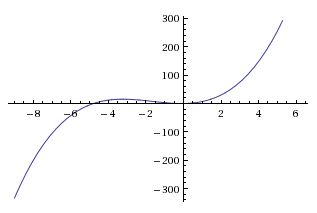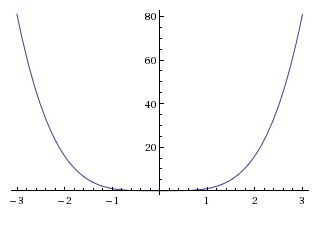- ↳ To Infinity and Beyond. Introduction
- ↳ Review of Set Theory
- ↳ Functions
- ↳ Countability
- ↳ Cardinality
- ↳ Hilbert's Grand Hotel
- ↳ Review of Set Theory
To Infinity and Beyond
A Review of Set Theory: Functions
by Maliha Hossain, proud member of the Math Squad
Let $ f $ be a function from set $ A $ to set $ B $.
$ \Leftrightarrow f : A \rightarrow B $
Contents
Onto (Surjective)
Definition: The function $ f $ is said to be surjective (or to map $ A $ onto $ B $) if $ f(A) = B $; that is, if the range $ F(f) = B $. If $ f $ is a surjective function, we also say that $ f $ is a surjection.
In other words, if for every $ y $ in $ B $, there exists at least one $ x $ in $ A $ such that $ f(x) = y $, then $ f $ us onto $ B $.
e.g. Given that
$ f(x) = x^5, \forall x \in \mathbb{R}, f : \mathbb{R} \rightarrow \mathbb{R} $
then, $ f $ is onto the set R.
e.g. Given that
$ f(x) = x^2, \forall x \in \mathbb{R}, f : \mathbb{R} \rightarrow \mathbb{R} $
then, $ f $ is not onto the set R.
But if we define the domain of $ f $ such that
$ f(x) = x^2, \forall x \in \mathbb{R}, f : \mathbb{R} \rightarrow [0,\infty] $
then, $ f $ is not onto.
Figures one and two show some other examples of functions, one of which is onto and one which is not.
One-to-One (Injective)
Definition: The function $ f $ is said to be injective (or to be one-one) if whenever $ x_1 $ is not equal to $ x_2 $, then $ f(x_1) $ is not equal to $ f(x_2) $. If $ f $ is an injective function, we also say that $ f $ is a injection.
In other words, if $ x_1 $ and $ x_2 $ are in the domain of $ f $ and if $ f $ is one-to-one if either of the following is true
$ \begin{align} &\bullet x_1 \neq x_2 \Rightarrow f(x_1) \neq f(x_2) \\ &\bullet f(x_1) = f(x_2) \Rightarrow x_1 = x_2 \end{align} $
e.g. Given that
$ f(x) = x^5, \forall x \in \mathbb{R}, f : \mathbb{R} \rightarrow \mathbb{R} $
then, $ f $ is onto the set R.
e.g. Given that
$ f(x) = x^2, \forall x \in \mathbb{R}, f : \mathbb{R} \rightarrow \mathbb{R} $
then, $ f $ is not onto the set R.
But if we define the domain of $ f $ such that
$ f(x) = x^2, \forall x \in \mathbb{R}, f : \mathbb{R} \rightarrow [0,\infty] $
then, $ f $ is not onto.
Bijection
Countability
para from bartle and sherbert on infinite sets denumerable or countable
illustrate with set of even numbers. and diagram
irrational numbers diagonal method with diagram
same cardinality
Cardinality
define cardinality
example
proof
References
- Bartle, Sherbert
- Kenney



